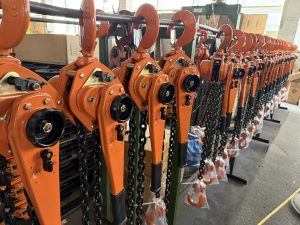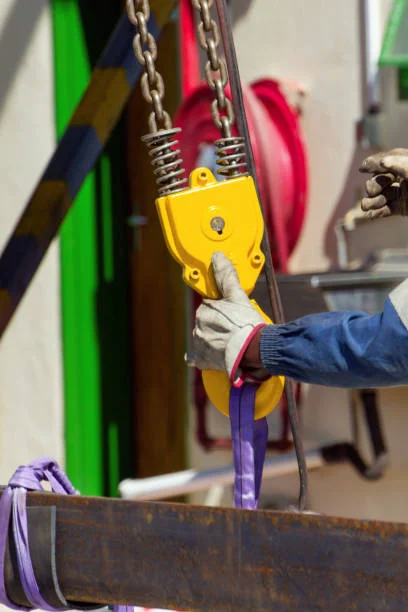Introduction to Handle Hoists
Handle hoists, also known as lever hoists or come-alongs, represent one of the most fundamental yet effective tools in material handling. These compact, portable devices combine simplicity with remarkable mechanical advantage, allowing a single operator to lift, pull, or tension heavy loads with minimal effort. Unlike their more complex powered counterparts, handle hoists rely entirely on mechanical principles that have been understood for centuries, yet remain profoundly effective in modern industrial, construction, and maintenance applications.
The beauty of handle hoists lies in their elegant design – a carefully orchestrated assembly of gears, pawls, and levers that transforms modest human force into significant lifting or pulling power. This article will explore the inner workings of these remarkable tools, examining how their mechanical design creates such impressive capability from such simple components.

Fundamental Components of a Handle Hoist
The Lever Handle
At the heart of every handle hoist is the lever – the simple machine that provides the initial mechanical advantage. The operator applies force to the handle, which pivots on a fulcrum. This basic principle allows a relatively small input force to generate a much larger output force. The length of the handle directly influences the mechanical advantage – longer handles require less effort but more movement to achieve the same work.
Gearing System
Handle hoists employ a gear train that significantly multiplies the force applied through the lever. Most designs use a planetary gear system, where multiple small gears (planet gears) rotate around a central sun gear. This compact arrangement provides substantial gear reduction in a small package. The gear ratio determines how much the input force is multiplied – ratios of 50:1 or higher are common, meaning 50 pounds of force on the handle can lift 2,500 pounds.
Load Chain and Sprocket
The multiplied force from the gearing system transfers to a sprocket that engages with the load chain. This specially designed chain consists of interlocking links that fit precisely with the sprocket teeth. As the operator works the handle, the sprocket rotates, drawing the chain through the hoist and lifting or pulling the load. The chain’s design provides both flexibility for operation and strength for load-bearing.
Ratchet and Pawl Mechanism
Safety is paramount in any lifting device, and handle hoists achieve this through a ratchet and pawl system. This mechanism allows the load to be raised incrementally while preventing it from descending unintentionally. The pawl, a spring-loaded catch, engages with teeth on the ratchet wheel, permitting rotation in one direction while blocking it in the opposite direction. This provides both control during lifting and automatic braking when the handle is released.
The Mechanical Advantage in Action
Force Multiplication
The true magic of handle hoists lies in their ability to multiply force. This multiplication occurs in stages: first through the lever action of the handle, then through the gear reduction system. The combined effect can transform 20-30 pounds of operator effort into thousands of pounds of lifting capacity. This mechanical advantage follows the fundamental principle of simple machines: what you gain in force, you lose in distance. The operator must move the handle through a considerable arc to achieve a small amount of lift, but with dramatically reduced effort.
Efficiency Considerations
While handle hoists provide impressive force multiplication, they’re not 100% efficient. Friction in the gears, chain, and bearings consumes some of the input energy. High-quality hoists minimize these losses through precision machining, proper lubrication, and bearing surfaces. Typical efficiency ranges from 60% to 85%, meaning that of the theoretical mechanical advantage, a portion is lost to friction and other factors.
Operation and Control Mechanisms
Lifting Sequence
Operating a handle hoist follows a specific sequence. The operator moves the handle back and forth in a pumping motion. With each stroke, the ratchet mechanism allows the gears to turn in the lifting direction while the pawl prevents reverse rotation. The reversible pawl design in many hoists allows the operator to switch between lifting and lowering modes, providing complete control over the load position.
Load Control and Lowering
Controlled lowering is as important as lifting in many applications. Handle hoists typically feature a release mechanism that disengages the pawl from the ratchet, allowing controlled descent. The operator regulates the lowering speed through friction brakes or by carefully controlling the release lever. This precise control enables accurate positioning of loads, a critical feature in installation and assembly work.
Design Variations and Specialized Applications
Different Chain Types
While most handle hoists use alloy steel load chains, some specialized models employ other materials. Stainless steel chains resist corrosion in marine or chemical environments, while synthetic web slings offer lightweight alternatives for delicate surfaces. Each chain type has distinct advantages and limitations suited to specific applications.
Capacity and Size Options
Handle hoists come in various capacities, from light-duty models handling a few hundred pounds to heavy-duty versions rated for 10 tons or more. The physical size and weight of the hoist generally increase with capacity, presenting a trade-off between portability and capability. Selecting the appropriate capacity for the application is crucial for both safety and efficiency.
Safety Features and Considerations
Built-in Safety Mechanisms
Beyond the essential ratchet and pawl system, handle hoists incorporate additional safety features. Many include overload protection mechanisms that prevent operation beyond rated capacity. Automatic brakes engage if the operating speed exceeds safe limits, and redundant pawl systems provide backup catching in case of primary mechanism failure.
Operator Safety Practices
Proper operation is as important as mechanical safety features. Operators should always inspect hoists before use, checking for worn components, proper lubrication, and smooth operation. The load should be properly balanced and secured, and the operator should maintain a safe position during lifting operations. Regular maintenance and periodic professional inspections ensure long-term reliability and safety.
Advantages Over Alternative Lifting Devices
Portability and Versatility
Handle hoists excel in situations where powered equipment is impractical. Their compact size and independence from external power sources make them ideal for remote locations, confined spaces, and temporary setups. They can operate in any orientation – pulling horizontally, lifting vertically, or even pulling downward – a flexibility unmatched by many other lifting devices.
Precision Control
The incremental nature of handle hoist operation provides exceptional control for precise positioning. Operators can make minute adjustments to load position, making these tools invaluable for alignment, installation, and assembly tasks where millimeter accuracy matters.
Conclusion: The Enduring Value of Simple Design
In an age of increasingly complex and computerized equipment, the handle hoist stands as a testament to the enduring power of simple mechanical principles. Its design elegantly combines fundamental physics with practical engineering, creating a tool that is both remarkably capable and refreshingly straightforward. The continued widespread use of handle hoists across industries demonstrates that sometimes the most effective solutions are not the most complex, but those that perfectly balance capability, reliability, and simplicity.
From construction sites to manufacturing floors, from emergency response to routine maintenance, the handle hoist remains an indispensable tool. Its mechanical elegance serves as a reminder that understanding basic principles often yields the most practical and durable solutions to everyday challenges in material handling.


